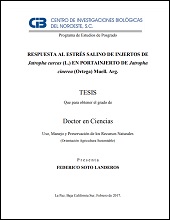| dc.contributor | LILIA ALCARAZ MELENDEZ | |
| dc.contributor | MIGUEL ANGEL ANGULO ESCALANTE | |
| dc.creator | FEDERICO SOTO LANDEROS | |
| dc.date | 2017-02-17 | |
| dc.identifier | http://cibnor.repositorioinstitucional.mx/jspui/handle/1001/419 | |
| dc.identifier.uri | http://dspace.cibnor.mx:8080/handle/123456789/2303 | |
| dc.description | Jatropha curcas ha sido investigada como fuente para producir biodiesel, debido a que su semilla contiene un alto porcentaje de aceite, además por su adaptabilidad a suelos pobres y clima extremo. Jatropha cinerea puede soportar largos períodos de sequía y tolerar hasta 100 mM de NaCl. El objetivo de este trabajo fue evaluar la respuesta al estrés salino de plantas injertadas, comparándolas con plantas no injertadas de J. curcas y J. cinerea. Para el estudio, 1) se realizó una descripción morfológica del polen de ambas especies y se incluyeron dos especies más, J. platyphylla y J. vernicosa. Los resultados palinológicos, muestran que los granos de polen de las variedades estudiadas, tienen similitudes en las características morfológicas y corresponden filogenéticamente a las asignadas al género. 2) Se realizaron injertos entre plantas de J. curcas y J. cinerea, para conocer su compatibilidad anatómica y porcentaje de sobrevivencia. La compatibilidad de injertos de J. curcas sobre portainjertos de J. cinerea, fue de 95% de sobrevivencia del total de plantas injertadas. Al comparar los diferentes tejidos, las células de parénquima de J. curcas tuvieron menor cantidad de granos de almidón que las de J. cinerea. Otra diferencia anatómica fue la amplitud del cambium vascular, en la que J. cinerea presentó mayor área que J. curcas. 3) Las plantas injertadas desarrolladas, fueron sometidas a diferentes niveles de salinidad (0 a 100 mM de NaCl). En los tratamientos con NaCl, los análisis bioquímicos presentaron un incremento en la actividad enzimática antioxidante (SOD, CAT y POX), en J. curcas, J. cinerea y J. injertada, conforme aumentaba la concentración de NaCl. Las plantas más afectadas fueron J. curcas con la concentración de 100 mM. J. cinerea y J. injertada presentaron mayor tolerancia para la misma concentración (100 mM). 4) Se obtuvieron semillas de plantas injertadas y no injertadas, para conocer el contenido de aceite. Las plantas injertadas presentaron mayor altura (150.7 cm) y contenido de aceite (51.3%) que las plantas no injertadas, (123.5 cm y 49.2%), sin afectar la composición de los ácidos grasos. 5) Los análisis fisiológicos, muestran que J. cinerea y J. injertada, tienen mayor capacidad para evitar la descomposición de la clorofila, y mantener valores más altos de conductividad, transpiración y asimilación de CO2, con respecto a J. curcas [...] | |
| dc.description | Jatropha curcas has been investigated as a source to produce biodiesel, because its seed contains a high percentage of oil, in addition for its adaptability to poor soils and extreme climate. Jatropha cinerea can withstand long periods and tolerate up to 100 mM NaCl. The aim of this study was to evaluate the response to saline stress of grafted plants, comparing them with ungrafted plants of J. curcas and J. cinerea. For the study, 1) a morphological description of the pollen of both species and two more species were included, J. platyphylla and J. vernicosa. The palynological results show that the pollen grains of the studied varieties have similarities in the morphological characteristics and correspond phylogenetically to those assigned to the genus. 2) Grafts were performed between plants of J. curcas and J. cinerea, to know their anatomical compatibility and survival percentage. The compatibility of J. curcas grafts on J. cinerea rootstocks was 95% of total grafted survival. When comparing the different tissues, the parenchyma cells of J. curcas had smaller amounts of starch grains than those of J. cinerea. Another anatomical difference was the amplitude of the vascular cambium, in which J. cinerea presented greater area than J. curcas. 3) The grafted plants developed were subjected to different levels of salinity (0 to 100 mM of NaCl). In the NaCl treatments, the biochemical analyzes presented an increase in the enzymatic activity (SOD, CAT and POX), in J. curcas, J. cinerea and J. grafted, as the NaCl concentration increased. The most affected plants were J. curcas with a concentration of 100 mM. J. cinerea and J. grafted presented higher tolerance for the same concentration (100 mM). 4) Seeds from grafted and ungrafted plants were obtained to determine the oil content. The grafted plants presented higher height (150.7 cm) and oil content (51.3%) than non-grafted plants (123.5 cm and 49.2%), without affecting the composition of the fatty acids. 5) The physiological analyzes show that J. cinerea and J. grafted have a greater capacity to avoid the decomposition of chlorophyll and to maintain higher values of conductivity, transpiration and assimilation of CO2 with respect to J. curcas [...] | |
| dc.format | application/pdf | |
| dc.language | spa | |
| dc.publisher | Centro de Investigaciones Biológicas del Noroeste, S.C. | |
| dc.rights | info:eu-repo/semantics/openAccess | |
| dc.rights | http://creativecommons.org/licenses/by-nc-nd/4.0 | |
| dc.subject | info:eu-repo/classification/AUTOR/Actividad enzimática; Fisiología; Histología; Injerto; Jatropha cinerea; Jatropha curcas; Jatropha platyphylla; Jatropha vernicosa; Portainjertos; Salinidad | |
| dc.subject | info:eu-repo/classification/cti/2 | |
| dc.subject | info:eu-repo/classification/cti/24 | |
| dc.subject | info:eu-repo/classification/cti/2417 | |
| dc.subject | info:eu-repo/classification/cti/241719 | |
| dc.subject | info:eu-repo/classification/cti/241719 | |
| dc.title | Respuesta al estrés salino de injertos de Jatropha curcas (L.) en portainjerto de Jatropha cinerea (Ortega) Muell. Arg. | |
| dc.type | info:eu-repo/semantics/doctoralThesis | |
| dc.type | info:eu-repo/semantics/publishedVersion | |



